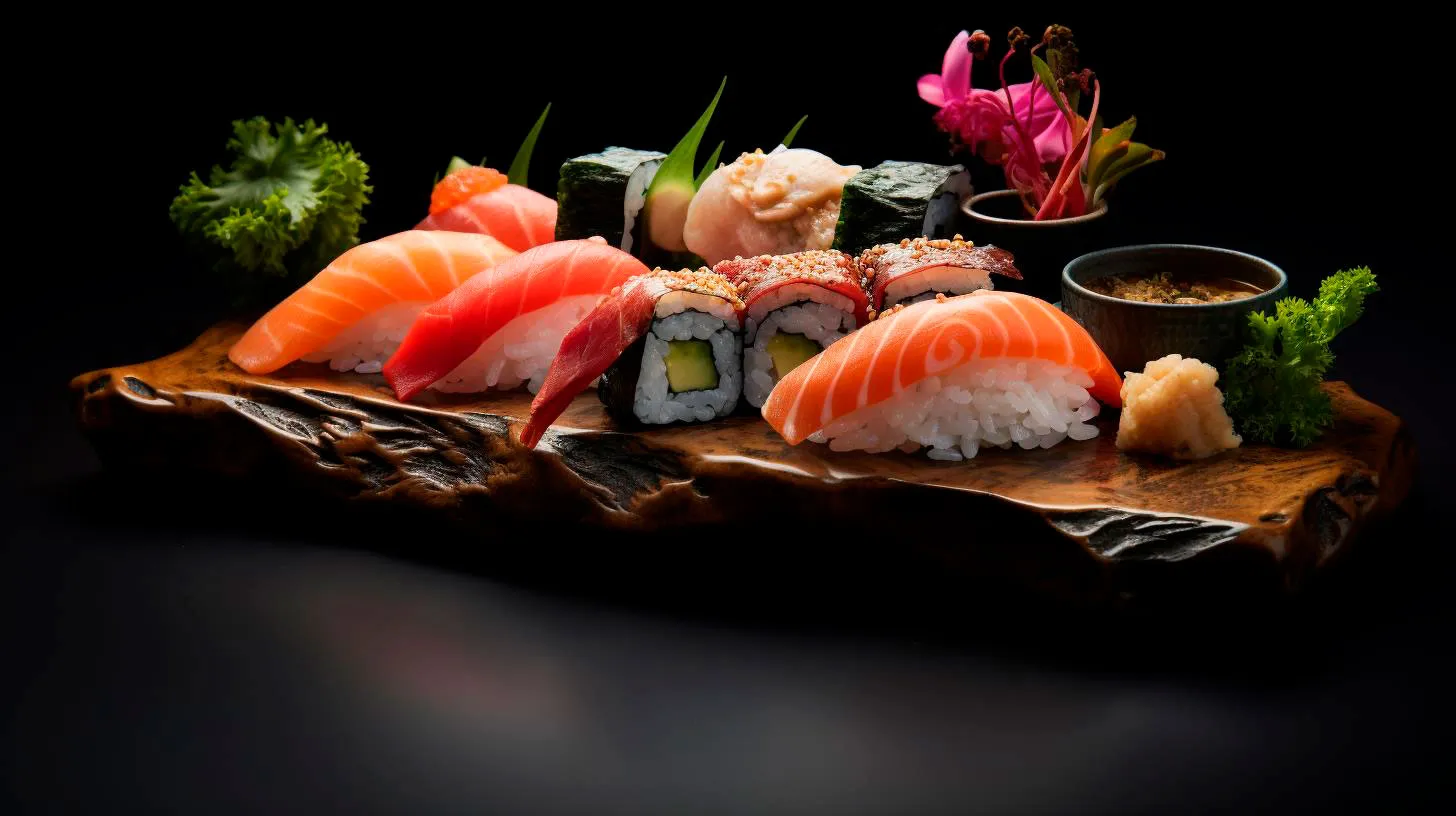How Sushi Rice Transforms from Paddy to Kitchen Staple
Let’s dive into the process of how sushi rice is cultivated, harvested, and processed to become a staple in sushi making.
The Journey Begins: Cultivating Sushi Rice
Cultivating sushi rice is an intricate process that demands specific conditions and expertise. Here are the key steps involved:
- Choosing the right variety: Sushi rice, also known as shari or sumeshi, is typically made from Japonica rice. This particular variety has short and sticky grains, making it ideal for sushi preparation.
- Sowing the seeds: Farmers sow the rice seeds directly into flooded fields, allowing the plants to grow in a water-rich environment.
- Nurturing the crop: Rice cultivation requires continuous monitoring and maintenance. Proper water management and fertilization are essential to ensure healthy growth.
- Preventing pests and diseases: Farmers employ various techniques to protect the rice crop from pests and diseases, such as using organic pesticides and implementing crop rotation.
Throughout the cultivation process, farmers leverage advanced technology and agricultural practices to optimize the quality and yield of sushi rice.
The Harvesting and Milling Process
Once the sushi rice reaches maturity, it is time for the harvesting and milling process. This critical phase ensures that the rice grains are polished to perfection, ready to be transformed into the sushi rice we know and love.
Here’s a breakdown of the harvesting and milling process:
- Harvesting: Farmers use modern machinery to cut and gather the rice stalks. The harvested rice is then dried to reduce the moisture content for storage.
- Hulling and polishing: The outer husk of the rice grain is removed through a mechanical process called hulling. This exposes the brown layer beneath, known as the bran. For sushi rice, the bran is polished away to achieve the desired texture and appearance.
- Grading: Sushi rice is meticulously sorted based on its grain size, shape, and quality. This grading process ensures consistency and uniformity in the final product.
Once the sushi rice undergoes these steps, it is now ready to make its way into sushi restaurants and kitchens worldwide.
Key Takeaways and Advantages
The journey of sushi rice from paddy to kitchen staple is a fascinating one. Here are a few key takeaways and advantages of sushi rice:
- Sticky texture: Sushi rice’s sticky nature allows it to hold its shape when rolled into sushi and makes it easier to eat with chopsticks.
- Absorbs flavors: Sushi rice has an innate ability to absorb the flavors of sauces and toppings, enhancing the overall taste of sushi.
- High-quality carbohydrates: Sushi rice is an excellent source of energy due to its high carbohydrate content, providing fuel for the body.
- Versatility: Sushi rice isn’t limited to just sushi. It can be used in various other dishes, such as rice bowls or side dishes.
Statistics on Sushi Rice Consumption
Here are some interesting statistics that showcase the popularity and consumption of sushi rice:
- In 2019, the global sushi rice market was valued at $5.16 billion, and it is projected to reach $6.97 billion by 2027, growing at a CAGR of 3.9%.
- The United States is one of the largest consumers of sushi rice, accounting for over 70% of the North American market.
- On average, a sushi chef uses approximately 20 kilograms of sushi rice per day in a busy sushi restaurant.
- Sushi rice consumption has been steadily increasing worldwide, driven by the growing popularity of Japanese cuisine and the rising trend of healthy eating.
From its cultivation to its place at the heart of sushi-making, sushi rice undergoes a captivating journey. The transformation from paddy to kitchen staple involves meticulous farming practices, the artful milling process, and the grading that ensures its exceptional quality. Sushi rice not only serves as the foundation for the beloved sushi dish but also offers versatility in the culinary realm. So, the next time you enjoy a piece of sushi, appreciate the remarkable journey of the rice that makes it all possible.
Unveiling the Meticulous Process of Producing Sushi Rice
In this article, we explore the fascinating journey of sushi rice from seed to table and how each step contributes to the sublime taste and texture that we all love.
1. Cultivating Perfect Sushi Rice
The journey of sushi rice begins in the lush paddy fields of Japan. Farmers carefully select the finest rice strains that are specifically bred for sushi. These varieties, such as Koshihikari and Sasanishiki, are known for their high starch content and subtle flavors, making them ideal for sushi rice.
The cultivation process involves meticulous care, as the rice plants require specific conditions to thrive. The fields are flooded with water to keep the soil moist, allowing the rice to grow properly. Farmers also monitor the temperature and adjust it accordingly to create an optimal environment for the rice plants to flourish.
Key Takeaways:
- Selecting specific rice strains bred for sushi
- Maintaining moist soil by flooding paddy fields
- Monitoring temperature to create an optimal environment
2. Harvesting and Polishing the Rice
After months of careful nurturing, the rice plants are ready to be harvested. This process requires precision to ensure that the grains are harvested at the perfect time, when they have reached optimal maturity. Experienced farmers use the traditional method of hand-cutting the rice stalks, preserving the delicate grains.
Once harvested, the rice undergoes a meticulous polishing process to remove the bran and germ layers, leaving behind the pure white, pearl-like grains that we associate with sushi rice. Polishing not only enhances the appearance but also removes any impurities and provides a smoother texture.
Key Takeaways:
- Precise timing for harvesting at optimal maturity
- Hand-cutting technique for preserving delicate grains
- Meticulous polishing to remove bran and germ layers
3. Washing and Steaming for Flawless Texture
Once polished, the rice is carefully washed to remove any residual debris and excess starch. The washing process also helps to enhance the rice’s texture, allowing it to absorb water evenly during cooking. Sushi chefs practice a gentle rinsing method to preserve the integrity of each individual grain.
After washing, the rice is steamed using precise measurements of water and cooking time. This step is crucial to achieve the desired texture – slightly sticky and tender, yet with a distinct separation of grains. The steamed rice is left to cool, allowing the flavors to develop and settle.
Key Takeaways:
- Gentle rinsing to remove debris and excess starch
- Precise steaming to achieve perfect texture
- Allowing the rice to cool for flavor development
4. Seasoning the Rice with Vinegar
The final step in the process involves seasoning the rice with vinegar, sugar, and salt. This step imparts the distinctive tangy flavor that complements the fish and other sushi ingredients. Sushi chefs meticulously mix the vinegar seasoning into the rice, gently folding it to ensure an even distribution without breaking the delicate grains.
After seasoning, the sushi rice is ready to be crafted into various types of sushi, showcasing the sublime taste and texture that is synonymous with this beloved Japanese delicacy.
Key Takeaways:
- Seasoning with vinegar, sugar, and salt for tangy flavor
- Gentle folding technique for even distribution
- Creating the perfect base for various types of sushi
The Art of Sushi Rice
Behind every delicious sushi roll is a meticulous process that transforms ordinary rice into a delectable masterpiece. From the careful cultivation to the precise polishing, washing, steaming, and seasoning, each step contributes to the final result.
Understanding the intricate process of producing sushi rice not only allows us to appreciate the craftsmanship behind this culinary delight, but it also enhances our dining experience. So, the next time you indulge in a sushi feast, take a moment to savor the artistry in every grain of rice, knowing that it has undergone a truly meticulous journey.
Exploring the Amazing Journey of Sushi Rice from Farm to Table
In this blog post, we will take a deep dive into the fascinating journey of sushi rice from the farm to your table.
The Cultivation Process
The journey of sushi rice starts with its cultivation process, which requires meticulous attention to detail. Here’s a step-by-step breakdown of how sushi rice is grown:
- Field Preparation: Farmers carefully prepare the paddy fields, ensuring the proper irrigation and drainage systems are in place.
- Seed Selection: High-quality rice seeds are carefully selected for their ability to produce the desired taste, texture, and stickiness.
- Planting: The selected rice seeds are then sowed in the prepared fields, usually during the spring season.
- Growth and Care: Farmers closely monitor the growth of the rice plants, ensuring they receive adequate sunlight, water, and nutrients.
- Harvesting: Once the rice plants reach maturity, they are harvested using specialized machinery.
It is worth noting that sushi rice is typically grown in specific regions known for their optimal climate and soil conditions. Countries like Japan, the United States, and Thailand are renowned for producing high-quality sushi rice.
The Milling and Polishing Process
After harvesting, the rice grains go through a series of processes to enhance their quality and remove impurities. The milling and polishing process plays a critical role in sushi rice production. Here are the key steps involved:
- Hulling: The outer husk of the rice grain is removed through mechanical hulling machines.
- Polishing: The rice grains are then polished to remove the bran layer, resulting in a shiny appearance.
- Sifting and Grading: The polished grains are sifted to remove any broken or undesirable parts. They are then graded based on size, color, and quality.
The milling and polishing process ensures that only the finest sushi rice grains make it to the market, delivering a superior culinary experience.
The Packaging and Distribution Process
Once the sushi rice grains are milled and polished, they are packaged and prepared for distribution. These are the key steps involved in this phase:
- Quality Control: To ensure consistent quality, sushi rice undergoes strict quality control measures, including tasting and visual inspection.
- Packaging: The sushi rice is then carefully packaged in airtight containers to maintain freshness and prevent moisture.
- Distribution: From the packaging facility, sushi rice is distributed to local markets, grocery stores, and even sushi restaurants.
It’s important to note that sushi rice is often transported and stored under specific conditions to preserve its quality and taste.
The Final Destination: Your Table
After its remarkable journey from the farm to the packaging facility, sushi rice finally reaches its ultimate destination: your table. Here are some key takeaways about sushi rice:
- Foundation of Sushi: Sushi rice forms the foundation of any sushi dish, providing a sticky texture and subtle flavor that perfectly complements the other ingredients.
- Important Nutrients: Sushi rice is a good source of carbohydrates and provides essential nutrients like thiamine and niacin.
- Cultural Significance: Sushi rice is deeply rooted in Japanese culture and has gained popularity worldwide, becoming a staple in Japanese cuisine.
- Versatility: Sushi rice is not just limited to sushi rolls. It can be used in various other dishes like rice bowls and sushi salads.
Now, the next time you savor a delectable piece of sushi, take a moment to appreciate the incredible journey the sushi rice has taken to reach your plate. From the meticulously cultivated fields to the rigorous processing and finally, to your table, sushi rice truly has an incredible story to tell.
The Cultural Evolution of Sushi Rice
The rice used in sushi is not your ordinary steamed rice. Sushi rice, also known as shari, is a special kind of short-grain rice mixed with rice vinegar, sugar, and salt. It provides the perfect base for shaping and holding together the various components of sushi rolls.
However, the cultural evolution of sushi rice goes beyond being a mere ingredient. Over the years, sushi rice has undergone significant changes, adapting to different palates and regional preferences. Let’s explore the fascinating journey of sushi rice through time.
The Origins of Sushi Rice
Sushi originated in Japan around the 8th century as a method of preserving fish by fermenting it with rice. At that time, the rice used in sushi was not consumed but discarded. It acted as a fermentation agent, enhancing the flavor and texture of the fish. This type of sushi, known as narezushi, was the precursor to modern sushi.
As time passed, sushi evolved, and the rice started to be consumed along with the fish. Towards the end of the 15th century, vinegared sushi rice became common in Japan. It was made by mixing steamed rice with rice vinegar, salt, and sometimes kombu (seaweed). This new style of sushi, known as haya-zushi, was the beginning of sushi as we know it today.
Regional Variations and Influences
As sushi gained popularity across Japan, different regions developed their own unique styles of sushi and adapted the rice accordingly. Here are some notable examples:
Edo-Mae Sushi
- Originating in Tokyo (formerly Edo), Edomae sushi became synonymous with nigiri sushi – hand-formed sushi topped with fresh fish or seafood.
- To complement the delicate flavors of the toppings, the rice was seasoned lightly to let the fish shine.
- Advantage: The focus on fresh, high-quality ingredients allows the natural flavors to take center stage.
Kansai-Style Sushi
- Hailing from the Kansai region, which includes Osaka and Kyoto, Kansai-style sushi is known for its milder flavors and emphasis on fermented toppings such as pickled vegetables.
- The rice used in Kansai-style sushi is seasoned more strongly to balance the tanginess of the toppings.
- Key Takeaway: The balance between the rice and fermented toppings creates complex and harmonious flavors.
Chirashi Sushi
- Chirashi sushi, meaning “scattered sushi,” is a style where sushi rice is topped with a colorful assortment of ingredients such as sashimi, vegetables, and omelet strips.
- The rice in chirashi sushi is typically seasoned with a slightly sweeter vinegar mixture to complement the variety of toppings.
- Feature: The vibrant presentation and diverse flavors make chirashi sushi a popular choice.
Sushi Rice Today
In recent times, the popularity of sushi has skyrocketed globally, leading to further adaptation and innovation in sushi rice. Here are some interesting trends:
- Sushi Burritos: Sushi rolled in large seaweed wraps, resembling burritos, have gained popularity in the United States and beyond. The larger size of the wraps calls for firmer rice seasoned with bolder flavors.
- Sushi Bowls: The rise of poke bowls and sushi bowls has introduced a new way of enjoying sushi. The rice in these bowls is often seasoned with a combination of soy sauce, sesame oil, and other Asian flavors.
- Sushi Fusion: Sushi has been fused with various cuisines, resulting in unique combinations like sushi burgers and sushi pizza. The rice in these innovative creations often incorporates spices and seasonings from different culinary traditions.
Sushi rice has come a long way from its humble beginnings as a means of preserving fish. It has transformed into an integral part of the sushi experience, adapting to different tastes and preferences around the world.
Next time you enjoy a plate of sushi, take a moment to appreciate the cultural evolution of the rice that holds it all together.



